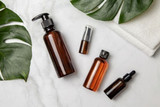A Primer on Cap and Liner Materials

Pharmaceutical industries, food manufacturers and chemical laboratories know the importance of choosing the right cap for their products. It’s an essential part of keeping your pills and syrups intact and far away from contaminants. A good-quality cap and the perfect liner protect the chemical components of the bottle from air and moisture.
So, if you’re planning to purchase packaging supplies for your products, it’s better to research before investing your money. Here’s a complete guide about different materials used for caps and bottle liners.
Understanding the Cap Material:
When it comes to caps, the list is pretty simple and short. There are three important materials used to manufacture closures for scientific applications:
Thermoset or Phenolic:
Thermoset (Bakelite) offers compatibility with a wide range of chemicals, which makes them a popular choice. They’re highly heat-resistant as compared to other plastic closures. However, they can’t be remolded once they’re shaped. That’s why they’re considered a strong and sturdy option.
When it comes to Phenolic (Phenol Formaldehyde Resin), they melt at 220°C or above. They’re non-reactive and aren’t as strong as other polymers, especially when exposed to corrosive chemicals.
Thermoplastic Closures:
Thermoplastic closures are also known as Polypropylene caps. They can be remolded once melted and have high-impact strength. These closures are also affordable when purchased in bulk and are autoclavable. The material can tolerate high temperatures. However, this type of cap isn’t suitable for extremely low temperatures. Their melting point is 130°C.
Metal Closures:
If you're looking for something that isn't fractured by impact, then metal closure is a good choice for your product. They can resist various temperatures and are the ideal choice for industrial applications and food packaging.

Such closures are either made of steel or aluminum. Steel caps are coated with a tin or chrome plate to avoid corrosion.
Understanding the Liner Material:
There are a variety of liner materials available in the market, some of which are mentioned below:
F217 & PTFE Lined Caps:
Foam-backed PTFE liners are suitable for almost all types of chemicals as they’re highly stable and resilient. They offer a low moisture transmission rate. With a low-density foam core, F217 PTFE caters to a wide range of applications, such as to cover analytical lab samples, strong acids, solvents, analytical samples, and pharmaceuticals.
Pulp/Vinyl Lined Caps:
Phenolic caps that have pulp and vinyl liners contain a vinyl coating and are laminated to pulp board. It's commonly seen as a closure medical applications, food and beverages. These liners aren't suitable for hydrocarbons or bleaches.
Recent Posts
-
Why Should You Choose Amber Glass When Packaging Beauty Products?
Designing a line of beauty products is no simple task. So many details go into planning and crafting …7th Jul 2022 -
Candle Supplies - The Benefits of Using Tins for Your Candle Business
Candle business is a fantastic way to turn a hobby into an extra income stream. For those willing an …7th Jul 2022 -
Customize your packaging and protect your products during shipping
Customize your packaging and protect your products during shipping. Our custom partitions are made i …5th Jul 2022



